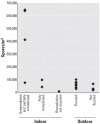Airborne mold and endotoxin concentrations in New Orleans, Louisiana, after flooding, October through November 2005
- PMID: 16966092
- PMCID: PMC1570051
- DOI: 10.1289/ehp.9198
Airborne mold and endotoxin concentrations in New Orleans, Louisiana, after flooding, October through November 2005
Abstract
Background: The hurricanes and flooding in New Orleans, Louisiana, in October and November 2005 resulted in damp conditions favorable to the dispersion of bioaerosols such as mold spores and endotoxin.
Objective: Our objective in this study was to assess potential human exposure to bioaerosols in New Orleans after the flooding of the city.
Methods: A team of investigators performed continuous airborne sampling for mold spores and endotoxin outdoors in flooded and nonflooded areas, and inside homes that had undergone various levels of remediation, for periods of 5-24 hr during the 2 months after the flooding.
Results: The estimated 24-hr mold concentrations ranged from 21,000 to 102,000 spores/m3 in outdoor air and from 11,000 to 645,000 spores/m3 in indoor air. The mean outdoor spore concentration in flooded areas was roughly double the concentration in nonflooded areas (66,167 vs. 33,179 spores/m3 ; p < 0.05) . The highest concentrations were inside homes. The most common mold species were from the genera of Cladosporium and Aspergillus/Penicillium ; Stachybotrys was detected in some indoor samples. The airborne endotoxin concentrations ranged from 0.6 to 8.3 EU (endotoxin units) /m3 but did not vary with flooded status or between indoor and outdoor environments.
Conclusions: The high concentration of mold measured indoors and outdoors in the New Orleans area is likely to be a significant respiratory hazard that should be monitored over time. Workers and returning residents should use appropriate personal protective equipment and exposure mitigation techniques to prevent respiratory morbidity and long-term health effects.
Figures


Similar articles
-
Characterization of airborne molds, endotoxins, and glucans in homes in New Orleans after Hurricanes Katrina and Rita.Appl Environ Microbiol. 2007 Mar;73(5):1630-4. doi: 10.1128/AEM.01973-06. Epub 2007 Jan 5. Appl Environ Microbiol. 2007. PMID: 17209066 Free PMC article.
-
Relation of indoor and outdoor airborne fungal spore levels in the Kansas City metropolitan area.Allergy Asthma Proc. 2017 Mar 1;38(2):130-135. doi: 10.2500/aap.2017.38.4030. Allergy Asthma Proc. 2017. PMID: 28234050
-
Resident cleanup activities, characteristics of flood-damaged homes and airborne microbial concentrations in New Orleans, Louisiana, October 2005.Environ Res. 2008 Mar;106(3):401-9. doi: 10.1016/j.envres.2007.11.004. Epub 2008 Jan 15. Environ Res. 2008. PMID: 18199434
-
Does evidence support measuring spore counts to identify dampness or mold in buildings? A literature review.J Expo Sci Environ Epidemiol. 2022 Mar;32(2):177-187. doi: 10.1038/s41370-021-00377-7. Epub 2021 Sep 2. J Expo Sci Environ Epidemiol. 2022. PMID: 34475494 Review.
-
Respiratory health effects of exposure to low levels of airborne endotoxin - a systematic review.Environ Health. 2018 Feb 8;17(1):14. doi: 10.1186/s12940-018-0360-7. Environ Health. 2018. PMID: 29422043 Free PMC article.
Cited by
-
Building-associated neurological damage modeled in human cells: a mechanism of neurotoxic effects by exposure to mycotoxins in the indoor environment.Mycopathologia. 2010 Dec;170(6):377-90. doi: 10.1007/s11046-010-9330-5. Epub 2010 Jun 13. Mycopathologia. 2010. PMID: 20549560
-
Cervico-Dorsal Intramedullary Spinal Cord Abscess with Aspergillus fumigates following Pulmonary Infection in an Immunocompetent Patient.Medicina (Kaunas). 2023 Apr 20;59(4):806. doi: 10.3390/medicina59040806. Medicina (Kaunas). 2023. PMID: 37109764 Free PMC article.
-
Projecting the Impacts of a Changing Climate: Tropical Cyclones and Flooding.Curr Environ Health Rep. 2022 Jun;9(2):244-262. doi: 10.1007/s40572-022-00340-0. Epub 2022 Apr 11. Curr Environ Health Rep. 2022. PMID: 35403997 Review.
-
Aspergillus genomes and the Aspergillus cloud.Nucleic Acids Res. 2009 Jan;37(Database issue):D509-14. doi: 10.1093/nar/gkn876. Epub 2008 Nov 27. Nucleic Acids Res. 2009. PMID: 19039001 Free PMC article.
-
The Head-off Environmental Asthma in Louisiana (HEAL) study--methods and study population.Environ Health Perspect. 2012 Nov;120(11):1592-9. doi: 10.1289/ehp.1104239. Epub 2012 Aug 15. Environ Health Perspect. 2012. PMID: 22895349 Free PMC article.
References
-
- Baxter DM, Perkins JL, McGhee CR, Seltzer JM. A regional comparison of mold spore concentrations outdoors and inside “clean” and “mold contaminated” Southern California buildings. J Occup Environ Hyg. 2005;2:8–18. - PubMed
-
- Belanger K, Beckett W, Triche E, Bracken MB, Holford T, Ren P, et al. Symptoms of wheeze and persistent cough in the first year of life: associations with indoor allergens, air contaminants, and maternal history of asthma. Am J Epidemiol. 2003;158(3):195–202. - PubMed
-
- Burge HP, Boise JR, Rutherford JA, Solomon WR. Comparative recoveries of airborne fungus spores by viable and non-viable modes of volumetric collection. Mycopathology. 1977;61:27–33. - PubMed
-
- Bush RK, Portnoy JM, Saxon A, Terr AI, Wood RA. The medical effects of mold exposure. J Allergy Clin Immunol. 2006;117(2):326–333. - PubMed
-
- CDC (Centers for Disease Control and Prevention) Health concerns associated with mold in water-damaged homes after Hurricanes Katrina and Rita—New Orleans area, Louisiana, October 2005. MMWR Morbid Mortal Wkly Rep. 2006;55(2):41–44. - PubMed

